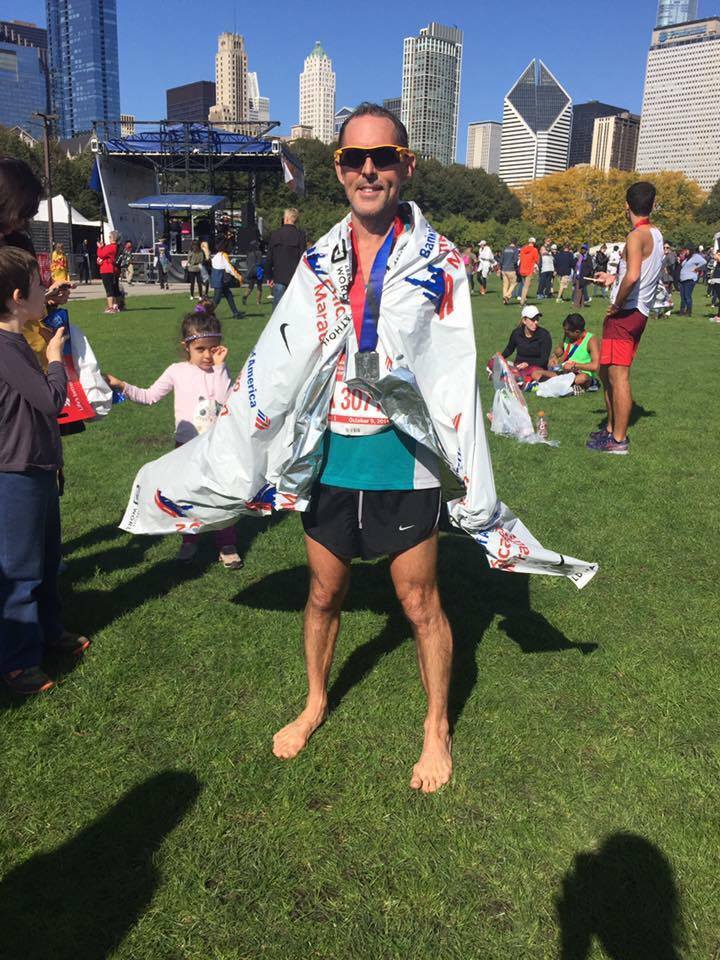
Sharing the story of online friend and fast Masters runner Thomas Cunningham. It’s never too late to learn new things about your inner machinery. Thomas see you in Hopkinton! Your butcher is right….the Ribeye is awesome and you cannot mess it up.
…………………
I ran my first marathon in 1994 in a time of 3:44. Over the last 23 years, I’ve been able to bring that time down significantly. I’ve run three sub-3:00 marathons, including a 2:58 in Boston last year. At 48 years old, I am still looking to improve, and I believe that my best race is ahead of me.
Last fall I made a couple of significant changes to diet and training, and I’m looking forward to seeing the results in Boston in a couple of weeks.
After last year’s Boston, I was pretty beat up emotionally and physically and didn’t run another step for two months. When I sat down an honestly looked at my preparation for that race, I recognized a couple of things – most importantly that I wasn’t recovering from my workouts as quickly as I used to. In fact, even when getting ten hours of sleep, I was not waking up refreshed.
Of course part of that can be chalked up to age. At forty-eight, I can’t realistically expect to bounce back like I did in my twenties. But I began to suspect that my diet might also be playing a role. I had been vegetarian for 23 years and was conscientious about eating as much high-quality food as I could – lots of kale, spinach, fruits, seeds, and nuts. But as many runners do, I balanced this against an equally large amount of pasta and bagels. I started noticing my training partners talking about all the steak they were eating. At the same time, it seemed that everywhere I turned there was a news report about the incorrect demonization of saturated fat by the sugar lobby. I could feel a change coming on, and I went and got some blood tests and learned that my B12 levels were in fact deficient.
One afternoon, I made a decision. I went to the local butcher shop and asked for a steak – I admitted to the butcher that I didn’t really know what I wanted as “it had been a while.” He recommended a ribeye steak, and when I sheepishly admitted that it had been more than 23 years, he gave me the steak as a gift. I cooked it up and ate it – with no GI distress – vowed to cut out the bagels and thus began my low carb journey.
Simultaneously I decided to adopt the Maffetone method and slowed down my training pace. To calculate my maximum aerobic training rate, I subtracted my age (48) from 180 to get 132. I’ve had asthma my entire life and have been on medicine for it for as long as I can remember, so I needed to subtract either ten beats for the medicine or five beats for the asthma – I went with the five beats for asthma as 122 bpm seemed impossibly low. Still, I set out and applied all of the discipline and will power I could muster. It was truly humbling as a 2:58 marathoner to be clocking off those 17-minute miles. I frequently found myself walking, walking very slowly, and, yes, even standing still waiting for my heart rate to come back down. I was embarrassed to post my two-mile “runs” on Strava, but I kept my eye on the prize. Other than the one race that I already had on my calendar (3:07 in Chicago marathon), I never ran faster than my MAF would allow.
Gradually I was able to run a mile continuously without walking, and now I find I can run steadily at 10-11 minutes per mile and stay at my MAF. In addition to feeling fitter, I found that my asthma cleared up and I have been able to taper off my daily medicine completely. I suspect this was due primarily to the elimination of the processed grains and secondarily to the low-stress running. Either way, I’ll take it. After four months or so, I decided to take back those five beats per minute for the asthma diagnosis and re-set my MAF to 132. I’m now often able to run 9:30-10:00 at that pace.
Last week, inspired by Dr. Mark’s recent post on Facebook, I went in for a VO2 max test to assess my fitness. More than anything, I was eager to see what my aerobic threshold is – whether the fat consumption and low-HR training had really converted me to a fat burner. I was also curious to see how efficient I was as a runner at my 132 MAF. I was delighted with my results – my VO2 max was 61 and max HR was 194, both excellent for a man my age. More than that, I was excited to see that my respiratory quotient (RQ) at 132 hovered right around .70 – total fat burning. I was all the way up to low 160s before the RQ went passed .85, and I tipped into burning more sugar than fat.
Armed with these new facts, I have adjusted my plan for the final five weeks before Boston. I will continue to run at 132 on recovery days, but on long runs I will push my HR into the high 150s.
I’m looking forward to a great Patriots’ Day and setting a new PR at 48.


Keep us posted!
Hey Thomas, how did it go in Boston? How did you feel? What advice would you give after training with MAF?
Thanks
Really wanted this backlinks list.